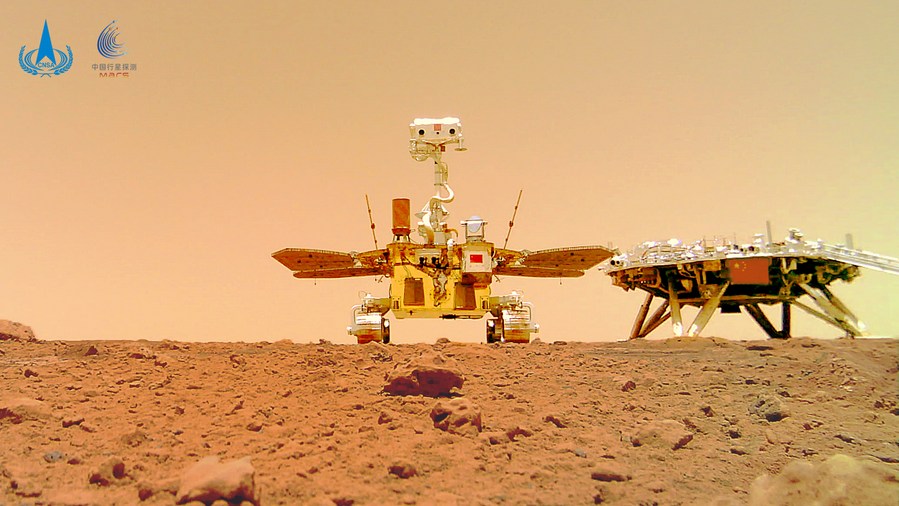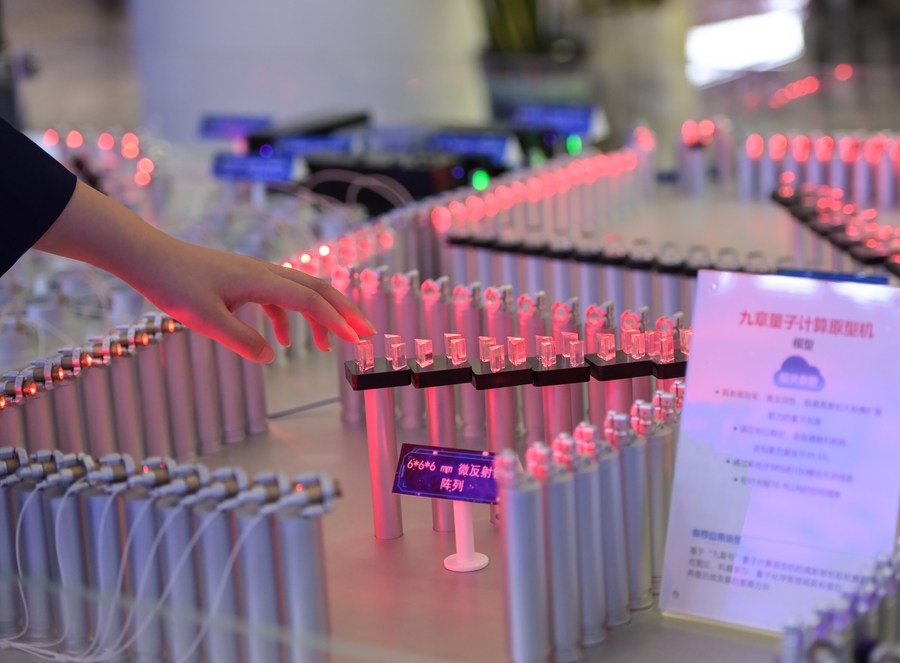A year of self-reliance: China's sci-tech highlights in 2021

The Long March-7 Y4 rocket, carrying Tianzhou-3, blasts off from the Wenchang Spacecraft Launch Site in south China's Hainan Province, Sept. 20, 2021. China launches cargo spacecraft Tianzhou-3 to deliver supplies for its under-construction space station. (Xinhua/Yang Guanyu)
BEIJING, Dec. 28 (Xinhua) -- For Chinese scientists and engineers, the past 12 months have been a year like no other.
With the pandemic still raging, scientific and technological self-reliance took center stage, bringing in advances in frontiers like space exploration, quantum science, and the battle against COVID-19.
At the Beijing Aerospace Control Center this year, Zhang Rongqiao and Sun Jun were no strangers to the "big red screen." The giant display turns red when a mission is declared a success.
On May 15, Zhang Rongqiao, chief designer of China's first Mars exploration mission, wiped tears from his eyes as Mars probe Tianwen-1 landed safely on the red planet. It was the country's first successful Mars mission and a giant leap for deep space exploration.

Zhang Rongqiao (R), chief designer of China's first Mars exploration mission, talks with Wu Weiren (2nd L), chief designer of China's lunar exploration project, at the Beijing Aerospace Control Center, after China's first Mars rover, Zhurong, drives down from its landing platform to the Martian surface, May 22, 2021. (Xinhua/Jin Liwang)
Launched on July 23, 2020, Tianwen-1 arrived at Mars in February and landed the lander and rover in May. Since then, the rover Zhurong has traveled more than 1,200 meters on the planet and is currently heading toward a region that might have been the coastline of an ancient ocean, looking for clues about Mars' evolution.
Earlier this month, Zhang was included on Nature's list of 10 people who were part of big stories in science in 2021. He said the landing gave him a taste of the old Chinese saying, "it takes 10 years to sharpen a good sword."
Sun Jun understands exactly what Zhang means by the old Chinese saying.

Photo released on June 11, 2021 by the China National Space Administration (CNSA) shows a selfie of China's first Mars rover Zhurong with the landing platform.(CNSA/Handout via Xinhua)
Sun, chief engineer of the space mission at the Beijing Aerospace Control Center, started with his colleagues in 1995. "We didn't have a single line of software code or computers, never mind a ready-to-use guidebook," he recalled.
This year, Sun and his colleagues witnessed "big red screen" moments multiple times: the launch of the space station core module Tianhe, two launches of the cargo freighters Tianzhou-2 and Tianzhou-3, two crewed flights of Shenzhou-12 and Shenzhou-13, the safe return to Earth of the Shenzhou-12 crew, four extravehicular activities and a live class from the space station.
"Now we can say that we can safely and freely build, control, operate, and maintain the space station," Sun told reporters this month.
Like space research and engineering, quantum research also continued to gain momentum this year. The quantum research team from the University of Science and Technology of China (USTC) again hit the highlight list of the year.
Last year, China's quantum computer, Jiuzhang, performed a calculation in 200 seconds that would take a supercomputer 2.5 billion years to complete.
Critics say it's unclear whether the problem a U.S. quantum computer solved was indeed beyond the capabilities of a conventional machine, and Jiuzhang is not easily reprogrammable to solve more than one problem.
In an interview with Outlook Weekly under Xinhua, Chinese quantum physicist Pan Jianwei said it took the team 20 years to make the breakthrough of Jiuzhang in 2020. They achieved a series of innovations on concepts and technologies this year, and Jiuzhang 2.0 arrived to address various issues.
In the 2021 "Highlights of the Year" story, the American Physical Society said "the USTC results stand out because they provided compelling arguments that a computer had finally achieved quantum primacy," a quantum system's ability to outperform the best possible classical computer in a given task. "The researchers observed exceptional quantum computational speedups that made the claim of quantum primacy hard to dispute."

A participant views a quantum computing prototype model during the 2021 Quantum Industry Conference in Hefei, east China's Anhui Province, Sept. 18, 2021. (Xinhua/Han Xu)
As space and quantum researchers reap the rewards from years of dedication, Chinese vaccine producers and drug developers have earned plaudits from racing against the clock to fight COVID-19.
Throughout the year, China has been promoting mass vaccination along with the global vaccination plan. Earlier this month, two COVID-19 medicines were granted emergency approval, China's first approved COVID-19 virus-neutralizing antibody combination therapy with independent intellectual property rights.

A batch of COVID-19 vaccine donated by China arrives at Robert Gabriel Mugabe International Airport in Harare, Zimbabwe, on Dec. 20, 2021. (Xinhua/Zhang Yuliang)
Self-reliant innovation never ends, noted Sun. "Core technologies can only come from a country's own innovation," he said. "You'd better hold the safety rope yourself, rather than leave it to others."
Although tensions and the pandemic limited international cooperation, China has never forgotten to share its achievements and make encouraging commitments to the international community.
The country has delivered on its promise to make vaccines global public goods and made continued efforts to improve vaccine accessibility and affordability in developing countries. Over 1.8 billion doses of COVID-19 vaccines have been provided to more than 120 countries and international organizations.

Aerial photo taken on March 29, 2021 shows China's Five-hundred-meter Aperture Spherical Radio Telescope (FAST) under maintenance in southwest China's Guizhou Province. (Xinhua/Ou Dongqu)
In March, China announced that its Five-hundred-meter Aperture Spherical Radio Telescope, the world's largest single-dish radio observatory, can be accessed by astronomers worldwide.
On Dec. 1, Tianwen-1 and the European Space Agency's Mars Express spacecraft successfully performed an in-orbit relay communication test. As the relay communication equipment interfaces of Zhurong and Mars Express match and conform to international standards, the Tianwen-1 and Mars Express teams will cooperate further in scientific data relay communication.
China has pledged to make its space station an open platform for international cooperation. A total of 17 countries will participate in the experiments aboard China's space station, covering aerospace medicine, life sciences and biotechnology, and astronomy.
Photos
Related Stories
Copyright © 2021 People's Daily Online. All Rights Reserved.










